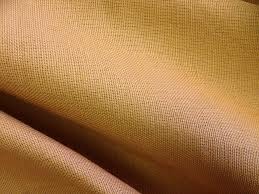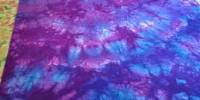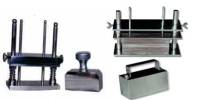Introduction:
A garment with immediate sales appeal is an essential objective for every clothing manufacturer. However, one of the most important components of nearly every garment is that which has little or no sales appeal because it is designed not to be seen: the fusible interlining.
The first known use of interlining for stiffening clothes was by the ancient Egyptians in about 3000 – 4000 BC. The nobles of that time wished to present an image of power and authority, and among other things, this was done by wearing enlarged and exaggerated clothes and hats.
Large parts of their garments were stiffened with heavy fabrics interwoven with metallic threads or strips, frequently made from gold or other precious metals. At different period of history the elaboration of garment styles called for stiffening materials and for many centuries, buckram and linen interlinings were used for this purpose.
Until the nineteenth century, buckram a coarse cotton fabric stiffened with glue was widely used as an interlining. This material was gradually replaced by interlinings that included animal hair in their construction. The most widely used hair cloth was that made from the hair of horse tails and with various refinements, this was used as an interlining for more than 150 years.
Fusible were first introduced or a large scale in the 1950s and they started what has since been called the third clothing revolution, the other two being the discovery of weaving and the invention of the sewing machine.
Since then, the fusing of garment components has become an integral part of clothing technology. Today, it is widely accepted that garment quality and durability are inexorably bound to the quality and application of the fusible used.
This topic and the item are originally compiled for the students of clothing technology and the objective was to present a restated selection of the literature available under this assignment.
AIM AND OBJECTIVES
The term “fusible interlining” is generally defined as a base fabric having a deposit of thermoplastic adhesive resin usually on one surface only, which can be bonded to another fabric by the application of heat and pressure.
The development of fusible was a fairly rapid process and required the combination of three separate technologies:
1. Textile: To produce the necessary types of base cloths.
2. Resin: To produce thermoplastic adhesives for heat bonding.
3. Engineering to produce machines that would fuse the interlining to the top-cloth.
Today the use of fusible for mass-produced clothing instead of the traditional sew-in type of interlining offers many advantages to both the manufacturers and the wearer. These superiorities can be summed up as follows:
1. For the manufacturer
2. For the wearer.
Thus, from all points of view, the use of fusible for mass produced cloths offers many advantages in terms of garment production and garment performance. Typical examples of the application and garment performance are shown in this assignment.
The topic “Application of fusible interlining on apparels” is the timely attempt to imply the process that occurred on apparel is greatly accepted for knowing and generating our future steps. We are absolutely fascinated to get some vital facts about the itemized topic that would be the right affect in our running garments sector.
So our actual aim or objective is implementation the gathered experience and finalized the correct invention that would be the pioneer for our future development on the apparel market in the country as well as the whole world and also we want to share our experience with other for making a different kind of modern apparel that would be a new task for fashion market in globalization period. So just we need to check it out more and more by practical work on apparel.
DEFINATION OF INTERLINING
Interlining is one kind of accessories which is used between two layers of fabric in garment to support reinforce and control areas of garments and to remain actual shape. It may be applied on base fabric by sewing or bounding the fronts of jackets and coats.
Interlining is a layer of fabric inserted between the face and the lining of a garment, drapery, or quilt. Interlining is similar to batting, a thick layer of fiber designed to provide insulation, loft, and body to quilts, pillow toppers, and heavy winter jackets.
Generally, interlinings are soft, thick, and flexible. Some interlinings are designed to be fused, while others are intended to be sewn to one or both layers of the textile. As an inner lining within textiles, interlining is used in a number of applications.
Though the consumer never sees it, interlining is the difference between a good winter coat and a great one, or lush full drapes and listless hanging fabrics.
In many cases, interlining serves as an additional layer of insulation. For example, drapes are often interlined with flannel or a similarly thick material to keep rooms warmer in winter and cooler in summer, while many winter coats and pants use a thick layer of interlining to protect the wearer from the elements.
Some of these garments also feature removable interlinings, so that they can be worn in warmer weather as well.
Factors that contribute to the aesthetics and performance of interlinings are material (fiber) content, weight and fabrication. Combinations of these factors produce the specific performance characteristics of particular interlinings.
Fiber content contributing to the strength, hand, weight, and resiliency of an interlining. Fibers may be blended to incorporate the best properties of each. Polyester and nylon fabric are used in fiber webs, woven, and knits to contribute strength, stability, and resiliency without adding bulk and weight.
Monofilament nylon fiber may be used for stiffness and resiliency, producing a lightweight material with little bulk. This type of interlining is often used in waistbands of skirts and slacks.
The main contribution of cotton and rayon is softness and hand. Wool and hair fibers may be used in hair canvas to provide resiliency and compatibility with wool piece goods. Hair canvas is widely used in better tailored suits and coats because of its resiliency and sharp retention.
Interlinings are available in a wide range from 0.4 to 4.0 ounces per square yard. Heavier interlinings provide more support for heavier more structured garments such as counts and suits. Lighter-weight interlinings offer resiliency and some support, but they may provide a softer hand.
However, lighter weight interlinings may provide less support, which may decrease the stability and resiliency of garments.
Interlinings are available in four basic fabrications; fiber webs, woven, knits and foam laminates. Fiber webs are the most widely used fabrication for interlinings because of their low cost, versatility, and the ease of engineering specific characteristics into the interlining. Fiber webs may have less strength but do not ravel in handling, which is a benefit during sewing operations.
The performance of interlinings made of fiber webs is very closely linked to fiber content, fabric weight in washable garments.
Fiber webs are frequently made from lightweight, strong, synthetic fibers such as nylon and polyester.
Fiber webs may have fibers randomly distributed or oriented in the lengthwise direction. Randomly arranged fibers allow some stretch in any direction.
Lengthwise orientation of fabric in fiber webs provides lengthwise stability and crosswise stretch.
Pilling is a problem often associated with fiber webs since fiber webs tend to have low abrasion resistance.
Over time, pilling of interlinings alters the hand of garments components and affects garment appearance.
Woven interlinings are usually plain weave and may be produced from almost any type of fabric. This fabrication is usually the most expensive and subject to raveling and shrinkage. Unless used as true bias for greater flexibility or as straight grain to stabilize a bias component, woven interlining should be cut on the same grain as the garment component for satisfactory performance.
The fabrics which are used as interlining are made from cotton, nylon, polyester, wool and viscose rayon or mixing of these different fibers. Woven or knitted fabric or non woven fabrics are used for interlining.
Sometimes finishing is necessary to improve its properties i. e. shirk resist finish, crease resist finish.
Depending on the application, interlining materials can be woven, knitted, or created by fusing fibers together. Silk, wool, and artificial fibers with good insulating qualities are common choices for interlining.
Selection of interlining with the appropriate properties for the fabric and style requires knowledge of the available products, the processes to be used, and an understanding of compatibility factors.
As styling needs change, producers of interlinings may create new fabrications, weights and adhesives with different properties.
Selecting the most appropriate interlining is not a simple task because many considerations must be taken into account. Interlinings must be compatible with piece goods and other materials used in the style, and they must be adaptable to the equipment used in the plant.
Appropriately chosen interlinings provide the foundation for the shape and hand of garments and the stability to maintain the same appearance through use, care, and storage. Aesthetic standards are often subjective and vary by designer.
Interlinings help from and maintain the hand, stability, durability and resiliency of the shell fabric. Hand refers to the drape, stiffness, or softness or softness of materials used in garments. Interlinings are available in a variety of different hands and must be analyzed with the shell fabric when determining the best combination.
Chemical composition, structure, sizing, coating, and/or resins a lot of bulk. Stiffness is important to those garments, components, or fabrics that require a lot of support but little bulk. Tailored shirt collars need a staffer interlining than soft, rolled collars.
Interlinings that are too staff cause rolled edges to break and buckle. The soft unstructured look that was popular during the 1990s did not mean interlinings wear omitted; their characteristics wear modified to produce a softer hand and better drape ability.
USING AREAS OF INTERLINING
Interlining can also be used to protect fabrics, especially those used in drapes and consequently often exposed to direct light. Delicate fabrics like silk and velvet can suffer from sun damage if hung with a liner alone, and most drapers recommend the use of an interlining for the life of the fabric.
In addition to protecting the fabric, the interlining also gives drapes a better form and fuller body. In quilting, a layer of interlining can offer an extra bit of fluffiness, along with warmth in the winter.
Garments with interlining tend to be stronger, because of the added layer of fabric support. In addition, they drape better, while keeping the wearer’s temperature relatively stable. Interlining generally bespeaks a higher level of quality in a garment, because of the additional manufacturing time involved.
Interlinings are materials that are fused or sewn to specific areas on the inside of garments or garment components. They may provide sharp, support, stabilization, reinforcement, hand and improved performance for garments.
Also called interfacings, particularly by the home sewing industry, interlinings are the most extensively used support material in ready-to-wear. Hundreds of different interlinings are really available from suppliers that specialize in support fabrics, but interlinings with special characteristics can also be engineered to meet the needs of a specific product or manufacturer.
(1) To produce and retain the desired aesthetic appearance
(2) To improve garment performance.
They are used for strength in relation to weight, low bulk, and smooth hand.
Weft insertion Rachel knits are used primarily as fusible interlinings winch adhesive applied to one surface. The weft insertion structure provides resiliency in the width, stability and control in the length, flexibility, and good drape ability with a soft hand.
This type of knit interlining is commonly used with wool and wool-blend fabrics because of their loft, soft hand, and resiliency. They are also used with knit fabric because of flexibility. Knit interlinings allow more tolerance for grain variation without affection performance than woven interlinings.
Interlining performance may be evaluated from two different perspectives; performance during production and performance in the finished garment. Manufacturers may select certain types of interlinings to facilitate handling and improve the sew ability of fabric and garment parts.
Interlinings may be used to reduce raveling and provide stability for the sewing process. They are frequently used under embroidery to stabilize fabrics for better-executed stitching.
The performance of the interlining can alter the performance of the shell fabric. Woven interlining used in collars and front shirt bands may be cut on the bias to provide good flexibility and shaping as the garment component rolls and bends, unlike the garment.
Knit fabric used for interlinings are primary warp knit tricots, raschels, and weft insertion raschels.
Foam substrates may be laminated to shell fabrics or linings to improve body and increase stiffness, durability, and warmth. Foam, which also provides insulation, may be used as interlining on budget- and moderate-priced cloth coats. Foam can provide body and shaping for an open, low-count fabric.
















